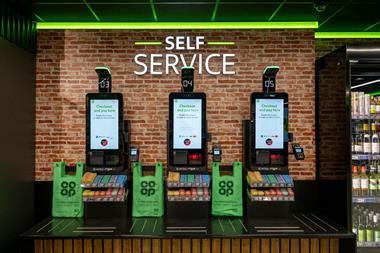Tesco’s US Fresh & Easy venture is expecting sales of US$1,000 (£511.30) a square foot of selling space each year – double the average of other US grocers. A little closer to home, John Lewis manages£400 a square foot, while Debenhams delivers£175.
Martec managing director Brian Hulme used these figures to open the Space Planning for Retailers conference in London in late May. He left the 40 or so retailers in the room in little doubt that they should be focused on driving yield from space they have already.
At a time when many retailers are struggling to maintain sales, tips on how to increase like-for-likes went down well. Superdrug head of space planning Simon Glass said: “The skill of the space planner is working out how to minimise compromises.” And, to achieve the best possible sales, the careful collection and analysis of multiple sources of data is becoming essential.
At Pets at Home, a project started last year has established new space-management processes. Working with retail consultant Javelin, the company has modelled space changes to try to work out what it should be selling in different types of stores.
Speaking at the conference, Pets at Home group development director John Farrell explained that the company’s SKU churn rate had reached 32 per cent a year. It needed to understand what the optimum space for different products was for stores in different localities and wanted to develop a longer-term space-planning strategy. The first step of the project to create the model was to set up a database of store catchment and performance data. Javelin and Pets at Home then grouped stores by performance and characteristics to create store clusters.
On top of this, rules were built into the model, such as minimum versus maximum space for given products and rules protecting space assigned to categories that are seen as strategic, even if sales don’t yet warrant it. From this, the model produced ideal allocations for different clusters and different store sizes.
The model came up with a theoretical like-for-like growth rate of between 6 to 8 per cent from making the recommended changes. However, not all these changes would be possible in real store environments, because of factors such as the layout of stores and range extensions not being available. To find out what would be feasible, Pets at Home embarked on a trial last year.
Farrell said that stores involved in the trial were chosen to show results by cluster, size and potential, because it was important that the trial was representative of the estate. 16 stores ran the trial for 16 weeks and this was expected to produce a like-for-like uplift of 3 to 4 per cent.
To implement the model, Pets at Home took some sub-categories out of certain stores. The retailer did not refit stores, so things had to be moved around and trial stores were given some extra man hours to allow for this.
The trial finished just before Christmas trading began and all categories showed an improvement, although Farrell admitted that they went a bit too far with some sub-categories and will tweak the calculations a bit for a roll-out. He said that the trial delivered a 1.8 per cent like-for-like sales increase and gave the retailer confidence that it could achieve the 3 to 4 per cent growth forecast if it extended its ranges.
A wider roll-out of the programme started in March. Pets at Home is introducing the model to 14 stores a week and will finish by the summer. Farrell said: “The numbers so far are exceeding the trial numbers and people tell me we have not skewed the roll-out towards the best stores.” However, he wants to wait until the end of the roll-out before drawing conclusions.
With plans to continue opening 20 stores a year, he explained that an added benefit is that Pets at Home can be certain it has the product mix right in the new stores from day one.
Farrell stressed that, when the roll-out ends in the summer, it will be only the beginning for the strategy and Pets at Home will bring more new products in. “The proof will be in the figures in the next couple of years,” he said.
However, it is not only retailers that are preoccupied with calculations on how much space should be given over to displaying different products. Unilever does work in the 12 categories where it produces products to examine how consumers interact with merchandise down to an SKU level. Speaking at the conference, Unilever UK merchandising manager Nick Widdowson used a case study of the company’s analysis of the pot snacks market to show just how seriously FMCG firms take the issue of the science of space.
Using eye-tracking devices, Unilever is able to record not just where consumers go when they shop, but also which products they look at and how long they look at them for before converting – putting the product in their trolley. In its study of the pot snacks market, Unilever used this to gather intelligence on where individual SKUs should be positioned on a display and where there were opportunities to increase sales by making changes to the assortment at an SKU level.
Widdowson said: “Only one in five shoppers pass the [pot snacks] section in store, only 3 per cent interact and 1 per cent convert, which is the lowest percentage for any category on the aisle.”
Sales in this market are focused on just a few SKUs and the layout of the pot snacks gives a balance between choice and availability. However, he said that once you include information on shopper interaction and film customers, you might change your decision on layout.
Activity that retailers should observe when creating a space planning model include initial interaction and the intensity of interaction with a section – ie, how many people looked at a particular SKU and how many times they looked at it. Widdowson explained that, from there, it is possible to build a picture to understand where a retailer should make changes to space allocation. For instance, looking at the diagrams the analysis produced on pot snacks, he said he would reduce the range and move the best-sellers up the display.
He said that this kind of analysis also helps a planner to start thinking about the objectives of a category and to identify the signpost brands.
Think this sounds complicated? This is just the start. Widdowson said that once you start looking at categories such as skincare, you have to multiply the complexity of the analysis tenfold. He admitted that in-store filming is quite expensive, so Unilever doesn’t film in a lot of stores. However, it has to have a big sample size where it does film, to ensure the results are statistically significant.
Widdowson added that the eye-tracking technology identifies which part of the packaging shoppers look at, something that has changed product design. He said that, in the past, a new product design has been halted one hour before final sign-off as a result of the eye-tracking research.
Widdowson believes in sharing the intelligence the company gathers with retailers. “We share information with retail buyers and merchandisers on about a dozen categories. There is no point us knowing this and not telling anyone. Ultimately, we are trying to make the fixture easier to shop and grow category sales,” he said.
With all this data that retailers now have access to, debate rages over whether they should further tailor each of their stores to local environments by implementing store-specific planograms, rather than the cluster-specific or one-size-fits-all approach that many take at present.
Woolworths space planning manager John Leventhall said at the conference that the ability to find differences between stores varies by retailer, but it is hard to find tradable differences. He said: “Local differences are another layer of icing on the cake, but it is a very thin and transparent layer.”
However, Asda space project manager Kate Gardner said: “In very competitive low-margin food retailing, looking at store-specific plans is something that food retailers will do.” However, Asda is only at the stage of doing cluster-specific plans at the moment.
Glass explained that Superdrug works on an ad-hoc basis to flex space where the retailer can. For example, it has found that stores in areas with larger Afro-Caribbean populations have higher sales of body skincare products. However, trends are not identifiable for many categories. He added that the JDA space-planning software that Superdrug has recently invested in will allow the retailer to integrate macro and micro space-planning better. However, he does not yet know whether this will lead to the retailer implementing store-specific planograms or ranges.
But before more retailers adopt tailored planograms, there is at least one further hurdle to overcome. Glass concludes: “We quite often walk into stores and find a bit of space that’s not on the plan. We make decisions from that information, but if you put rubbish in, you get rubbish out.” On that basis, more data needs to be collected and maintained if space planning is to yield better results.


























No comments yet